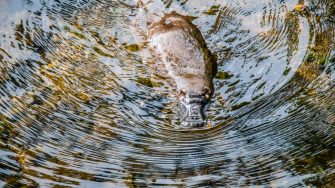
Synopsis
Platypuses are an iconic but cryptic species difficult to study in the wild, particularly aspects relating to reproduction and parental care. In captivity, weaning of young occurs rapidly as soon as they emerge from their nesting burrow, but it is still unclear if there is any further parental care. In the wild, data suggests that many juveniles stay in the mother’s home range for at least their first year before dispersing.
Aims
This project aims to study burrow locations of juveniles and adults in a wild population to determine proximity to relatives/conspecifics and if burrow sharing occurs. The results will provide the information required to make informed management decisions in captive breeding programs and understanding the relationships of individuals within wild populations.
Approach
The project will focus on platypuses in Coranderrk Creek, Healesville, Victoria. Platypuses will be trapped, fitted with a VHF radio-transmitter and released back into the creek. Platypuses will be radio-tracked daily to their burrow location and the site marked with GPS. Transmitters will stay attached to the animals for 30 – 120 days. The study will conclude when all the transmitters have fallen off. Collected genetic samples will be analysed for familial relationships to determine parentage.
Student benefits
- You’ll work with one of the most unique mammals on earth.
- You’ll gain extensive experience in a range of field methods during platypus surveys and monitoring in the Australian Snowy region.
- You’ll also develop good quantitative and statistical skills required to analyse collected data.
- You’ll also write a paper for peer-reviewed publication. There may be opportunities for a PhD following the project.
- You’ll be part of the dynamic Centre for Ecosystem Science and collaborate with researchers from UNSW and Healesville Sanctuary.
Get involved
To learn more about this project, contact Dr Gilad Bino & Dr Jessica Thomas
